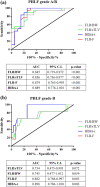The role of hepatobiliary scintigraphy combined with spect/ct in predicting severity of liver failure before major hepatectomy: a single-center pilot study
- PMID: 33136280
- PMCID: PMC7889556
- DOI: 10.1007/s13304-020-00907-2
The role of hepatobiliary scintigraphy combined with spect/ct in predicting severity of liver failure before major hepatectomy: a single-center pilot study
Abstract
Hepatobiliary scintigraphy (HBS) has been demonstrated to predict post-hepatectomy liver failure (PHLF). However, existing cutoff values for future liver remnant function (FLR-F) were previously set according to the "50-50 criteria" PHLF definition. Methods of calculation and fields of application in liver surgery have changed in the meantime. The aim of this study was to demonstrate the role of HBS combined with single photon emission computed tomography (SPECT/CT) in predicting severity of PHLF, according to the International Study Group of Liver Surgery (ISGLS). All patients submitted to major hepatectomy with preoperative HBS-SPECT/CT between November 2016 and December 2019, were analyzed. Patients were resected according to hepatic volumetry. Receiver operating characteristic (ROC) curve analysis was performed to identify cutoffs of FLR function for predicting PHLF according to ISGLS definition and grading. Of the 38 patients enrolled, 26 were submitted to one-stage hepatectomy (living liver donors = 4) and 12 to two-stage procedures (portal vein embolization = 4, ALPPS = 8). Overall, 18 patients developed PHLF according to ISGLS criteria: 12 of grade A (no change in the patient's clinical management) and 6 of grade B (change in clinical management). ROC analysis established increasingly higher cutoffs of FLR-F for predicting PHLF according to the "50-50 criteria", ISGLS grade B and ISGLS grade A/B, respectively. HBS with SPECT/CT may help to assess severity of PHLF following major hepatectomy. Prospective multicenter trials are needed to confirm the effective role of HBS-SPECT/CT in liver surgery.
Keywords: Hepatectomy; Hepatobiliary scintigraphy; Liver failure; Mebrofenin; SPECT.
Conflict of interest statement
The authors declare that they have no conflict of interest.
Figures






References
MeSH terms
LinkOut - more resources
Full Text Sources
Medical

